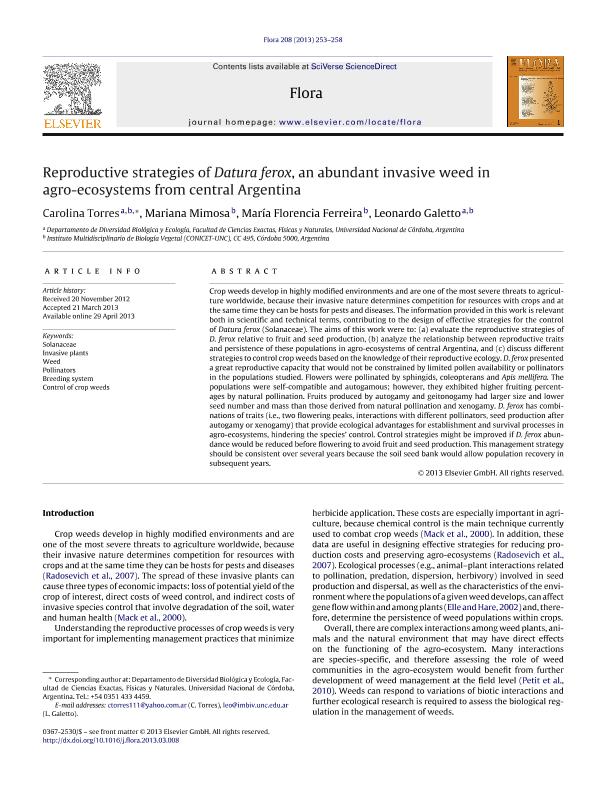Artículo
Reproductive strategies of Datura ferox L., an abundant invasive weed in agro-ecosystems from central Argentina.
Fecha de publicación:
04/2013
Editorial:
Elsevier Gmbh
Revista:
Flora
ISSN:
0367-2530
Idioma:
Inglés
Tipo de recurso:
Artículo publicado
Clasificación temática:
Resumen
Crop weeds develop in highly modified environments and are one of the most severe threats to agricul-ture worldwide, because their invasive nature determines competition for resources with crops and atthe same time they can be hosts for pests and diseases. The information provided in this work is relevantboth in scientific and technical terms, contributing to the design of effective strategies for the controlof Datura ferox (Solanaceae). The aims of this work were to: (a) evaluate the reproductive strategies ofD. ferox relative to fruit and seed production, (b) analyze the relationship between reproductive traitsand persistence of these populations in agro-ecosystems of central Argentina, and (c) discuss differentstrategies to control crop weeds based on the knowledge of their reproductive ecology. D. ferox presenteda great reproductive capacity that would not be constrained by limited pollen availability or pollinatorsin the populations studied. Flowers were pollinated by sphingids, coleopterans and Apis mellifera. Thepopulations were self-compatible and autogamous; however, they exhibited higher fruiting percent-ages by natural pollination. Fruits produced by autogamy and geitonogamy had larger size and lowerseed number and mass than those derived from natural pollination and xenogamy. D. ferox has combi-nations of traits (i.e., two flowering peaks, interactions with different pollinators, seed production afterautogamy or xenogamy) that provide ecological advantages for establishment and survival processes inagro-ecosystems, hindering the species? control. Control strategies might be improved if D. ferox abun-dance would be reduced before flowering to avoid fruit and seed production. This management strategyshould be consistent over several years because the soil seed bank would allow population recovery insubsequent years.
Palabras clave:
Invasive Plants
,
Weed
,
Pollinators
,
Breeding System
,
Control of Crop Weeds
Archivos asociados
Licencia
Identificadores
Colecciones
Articulos(IMBIV)
Articulos de INST.MULTIDISCIPL.DE BIOLOGIA VEGETAL (P)
Articulos de INST.MULTIDISCIPL.DE BIOLOGIA VEGETAL (P)
Citación
Torres, Carolina Cecilia; Mimosa, Mariana; Ferreira, María Florencia; Galetto, Leonardo; Reproductive strategies of Datura ferox L., an abundant invasive weed in agro-ecosystems from central Argentina.; Elsevier Gmbh; Flora; 208; 4; 4-2013; 253-258
Compartir
Altmétricas




